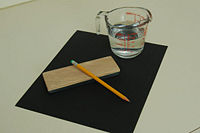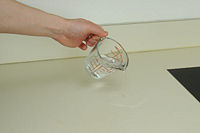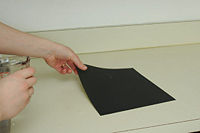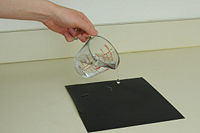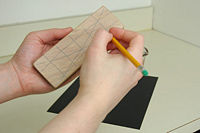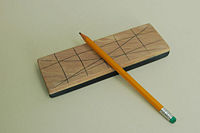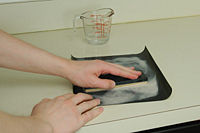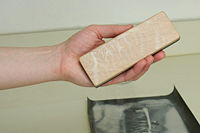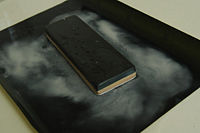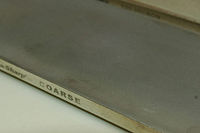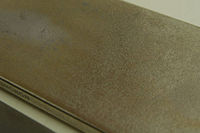Difference between revisions of "Hone Lapping 101"
| Line 19: | Line 19: | ||
Image:Hone_lapping_101DSC_2451.jpg | My coticule doesn't require soaking, so we'll just get started. | Image:Hone_lapping_101DSC_2451.jpg | My coticule doesn't require soaking, so we'll just get started. | ||
Image:Hone_lapping_101DSC_2457.jpg | Pour some water onto the countertop, then place the sandpaper on top of the puddle. This will create a suction that'll hold the sandpaper in place while you work. The smoother the surface, the better. | Image:Hone_lapping_101DSC_2457.jpg | Pour some water onto the countertop, then place the sandpaper on top of the puddle. This will create a suction that'll hold the sandpaper in place while you work. The smoother the surface, the better. | ||
| − | Image:Hone_lapping_101DSC_2458.jpg | | + | Image:Hone_lapping_101DSC_2458.jpg | Place the sandpaper down on the water. |
Image:Hone_lapping_101DSC_2459.jpg | When you have the sandpaper down, pour more water on top of the sandpaper. | Image:Hone_lapping_101DSC_2459.jpg | When you have the sandpaper down, pour more water on top of the sandpaper. | ||
Image:Hone_lapping_101DSC_2475.jpg | If you don't have a countertop that will work, you can get a piece of granite or marble tile at Home Depot or Lowes for about $5. | Image:Hone_lapping_101DSC_2475.jpg | If you don't have a countertop that will work, you can get a piece of granite or marble tile at Home Depot or Lowes for about $5. | ||
Image:Hone_lapping_101DSC_2454.jpg | The next step helps you figure out when the hone is flat. Take the pencil and draw a grid on the surface of the hone. | Image:Hone_lapping_101DSC_2454.jpg | The next step helps you figure out when the hone is flat. Take the pencil and draw a grid on the surface of the hone. | ||
| − | Image:Hone_lapping_101DSC_2456.jpg | | + | Image:Hone_lapping_101DSC_2456.jpg | This is an example of the grid pattern. |
Image:Hone_lapping_101DSC_2470.jpg | Place the hone face down on the sandpaper and start swirling it around. Don't use a lot of pressure--just lay your hand on top and move the hone. Some guys like to do figure 8 patterns on the paper. I usually just do small circles. You can try both and see which you like better. | Image:Hone_lapping_101DSC_2470.jpg | Place the hone face down on the sandpaper and start swirling it around. Don't use a lot of pressure--just lay your hand on top and move the hone. Some guys like to do figure 8 patterns on the paper. I usually just do small circles. You can try both and see which you like better. | ||
Image:Hone_lapping_101DSC_2466.jpg | Check the pencil grid on the surface frequently to see how you're progressing. On a new or badly worn vintage hone, it might take 10 or 15 minutes or more to get it completely flat. If you have an old barber hone, it could take several hours. | Image:Hone_lapping_101DSC_2466.jpg | Check the pencil grid on the surface frequently to see how you're progressing. On a new or badly worn vintage hone, it might take 10 or 15 minutes or more to get it completely flat. If you have an old barber hone, it could take several hours. | ||
Revision as of 12:59, 28 September 2008
Background
Most hones don't come with a flat honing surface. Vintage hones are usually worn from use; new hones aren't flat because of the manufacturing process. Before you use any hone for the first time, it's a good idea to flatten it. This is called lapping the hone.
You can do this with minimal investment. I lapped my hones for a long time with just a piece of wet-dry sandpaper and a flat surface to stick it to.
For this tutorial, I'll be lapping a Belgian yellow coticule. This is one of my main workhorse hones, and it hasn't been lapped in a while. I don't have a Norton 4K/8K combo hone, but the procedure is pretty similar with all hones.
Getting started
To start out, I have collected a pencil, some 320-grit wet-dry sandpaper, a glass of water, and my hone. We're going to use a smooth countertop as the lapping surface.
It's important to get good quality sandpaper. Norton and 3M are good brands. Cheap sandpaper could leave particles embedded in your hone.
The first time you lap your hone, I'd suggest starting with sandpaper in the 320 to 400-grit range. This coarse paper will flatten the hone quickly. If you'd like, you can experiment with finishing the honing surface with paper between 600 and 1000 grit. Some guys find that the higher grit papers leave a smoother honing surface.
If you have a Norton hone or other waterstone that requires soaking, place it in a bucket of water for 15 minutes before you start lapping it.
